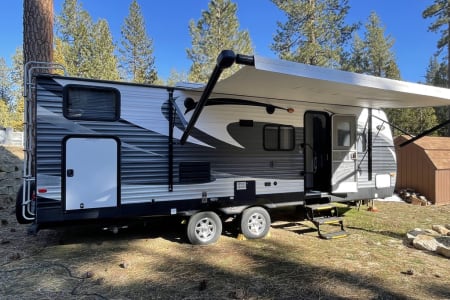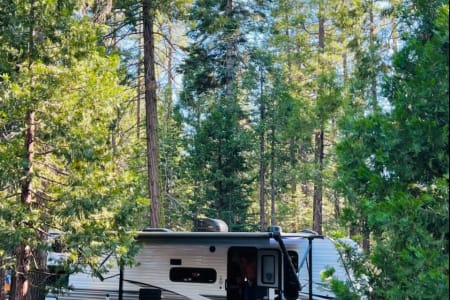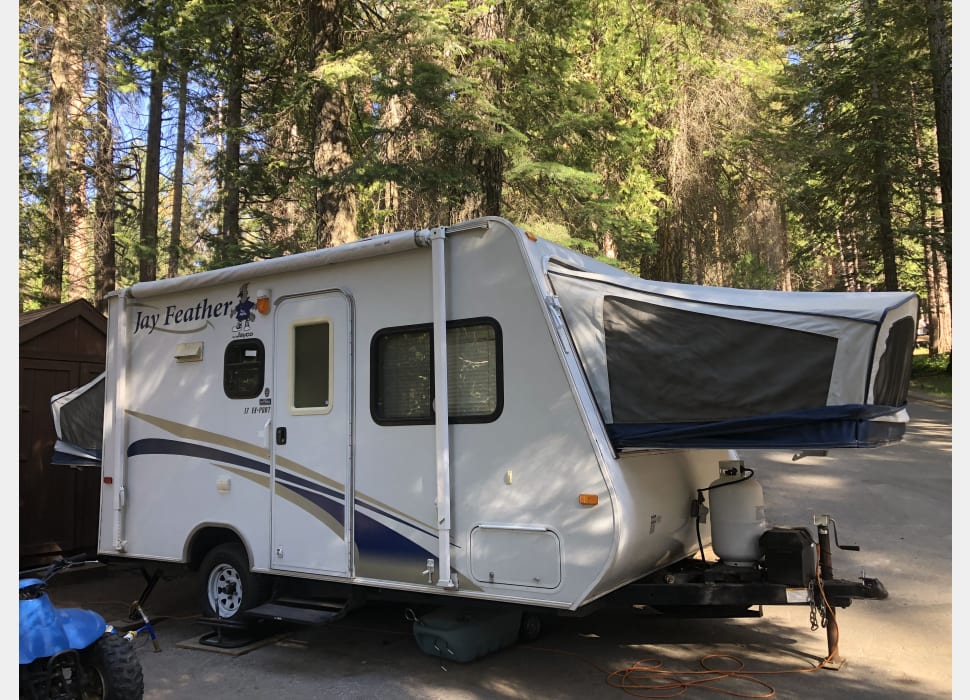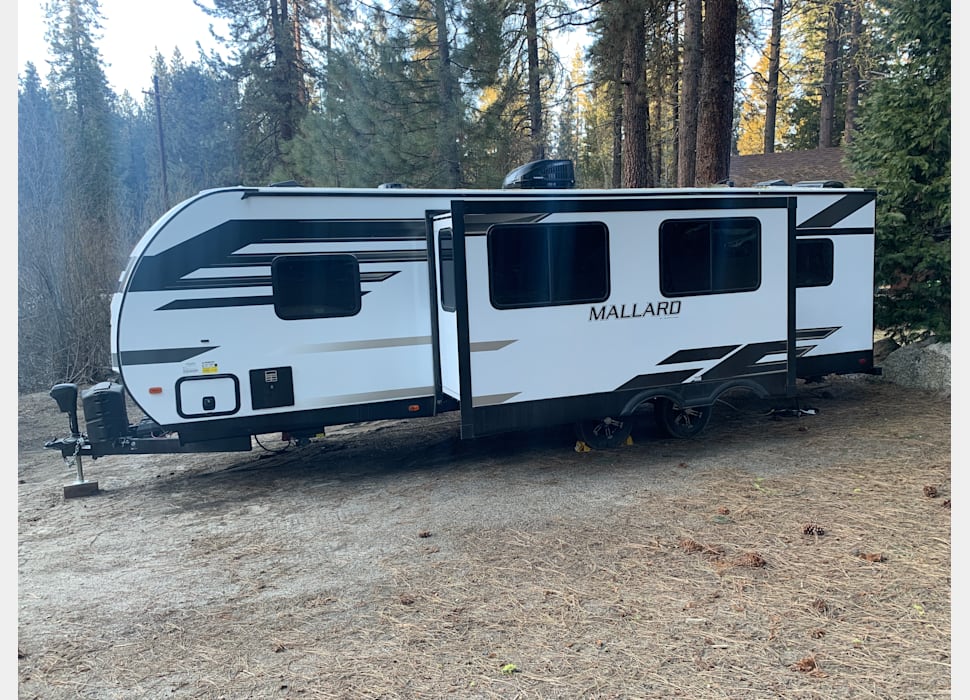Sequoia National Park California (CA) RV Rentals
RV Rentals Dates
RV Rentals near Sequoia National Park?
Introduction
Sequoia National Park is a haven for nature enthusiasts and RV campers alike. With its towering sequoia trees, rich history, and unique natural features, it’s no wonder this park attracts visitors from all over the world. Let’s delve into why Sequoia National Park is a great spot for RV camping, its historical and cultural significance, the natural occurrences that shaped its landscape, the weather and precautions for RV renters, and the exciting activities that await you.
RV camping in Sequoia National Park offers a one-of-a-kind experience surrounded by the beauty of nature. The park provides several campgrounds equipped with RV-friendly amenities, including electrical hook-ups and dump stations. Imagine waking up to the serene sounds of birds chirping and stepping outside your RV to witness the grandeur of towering sequoias. It’s an immersive camping experience that allows you to connect with nature while enjoying the comforts of your RV.
RVThereYet.com is an RV rental company, offering a diverse fleet of motorhomes, including Class A, Class B, and Class C Rentals, Travel, Trailers, and Motorhomes for unforgettable adventures in scenic RV parks and campsites in Sequoia National Park. Ensure early reservations for camper rentals at Sequoia National Park.
Transportation
-
Driving/Transportation
When visiting Sequoia National Park, private vehicle travel is the most convenient transportation option. Visitors can access the park from three main entrances: the Ash Mountain Entrance, the Foothills Visitor Center Entrance, and the Lodgepole Visitor Center Entrance. Each entrance provides access to different areas of the park, allowing visitors to explore its diverse landscapes and attractions. It’s important to note that there are restrictions on rig sizes, with the maximum length for vehicles set at 40 feet and a maximum combined length of 60 feet for vehicles towing a trailer or a fifth wheel.
-
Parking area
Sequoia National Park provides designated RV parking areas throughout the park allowing RV owners to conveniently explore its wonders. However overnight parking outside of designated campsites is not permitted. While it is possible to camp with an RV in the park it is recommended to explore using alternative transportation methods such as shuttle buses or hiking trails to fully experience the park’s beauty. This allows for easier navigation and access to various attractions without the hassle of finding parking spaces for larger vehicles.
-
Public Transportation
Sequoia National Park offers shuttle bus services and a network of walking paths for visitors to explore the park. The shuttle buses provide convenient transportation between major attractions and trailheads allowing for easy access to different areas of the park. Additionally there are various walking paths and trails available for those who prefer to explore on foot. These transportation options provide a sustainable and enjoyable way to navigate the park’s stunning landscapes and experience its natural wonders.
Top Campsites in Sequoia National Park
-
Reservations camping
Lodgepole Campground
Situated within Sequoia National Park Lodgepole Campground is the most popular choice for campers. With over 200 sites this campground offers a serene setting amidst towering trees and a nearby river. Activities include hiking fishing and wildlife viewing. Amenities include flush toilets picnic tables and fire rings. The campground is pet-friendly and open from late spring to early fall. RVs and trailers up to 40 feet in length are permitted.
Dorst Creek Campground
Located in Sequoia National Park Dorst Creek Campground is known for its peaceful atmosphere and beautiful surroundings. It offers around 200 campsites nestled among the trees. Visitors can enjoy hiking fishing and stargazing. Amenities include picnic tables fire rings and flush toilets. The campground is pet-friendly and open from late spring to early fall. RVs and trailers up to 30 feet in length are allowed.
Potwisha Campground
Situated in the foothills of Sequoia National Park Potwisha Campground is a popular choice for its scenic beauty and proximity to the park’s entrance. It offers around 40 campsites along the Kaweah River. Activities include hiking fishing and birdwatching. Amenities include picnic tables fire rings and vault toilets. The campground is pet-friendly and open year-round. RVs and trailers up to 24 feet in length can be accommodated.
Three Rivers Hideaway
Located just outside of Sequoia National Park Three Rivers Hideaway is a private KOA campground offering a range of amenities and activities. It features spacious RV sites with full hookups tent sites and cabins. Amenities include a swimming pool playground laundry facilities and a camp store. Activities include hiking fishing and river rafting. The campground is pet-friendly and open year-round. RVs and trailers of all sizes are permitted.
Please note that reservations are required for all of these campsites and availability may vary. It’s advisable to check with the respective campgrounds for the most up-to-date information and to secure your spot in advance.
-
First-come first-served
Buckeye Flat Campground
Buckeye Flat Campground offers a first-come-first-served camping experience in Sequoia National Park. It has around 28 campsites nestled in a picturesque setting. The campground is open from late spring to early fall providing ample opportunities to enjoy the park’s beauty. Accommodations include picnic tables fire rings and vault toilets. RVs and trailers up to 22 feet in length can be accommodated. Buckeye Flat Campground is pet-friendly allowing visitors to bring their furry friends along for the adventure.
Atwell Mill Campground
Located in the Mineral King area of Sequoia National Park Atwell Mill Campground is another first-come-first-served option. It offers approximately 21 campsites surrounded by stunning mountain scenery. The campground is open from late spring to early fall providing a limited window to experience its beauty. Accommodations include picnic tables fire rings and vault toilets. RVs and trailers up to 22 feet in length can be accommodated. Atwell Mill Campground is pet-friendly allowing visitors to bring their four-legged companions along for the outdoor fun.
South Fork Campground
South Fork Campground is a first-come-first-served campground located in the foothills of Sequoia National Park. It offers around 10 campsites nestled along the South Fork of the Kaweah River. The campground is open year-round providing opportunities for camping throughout the seasons. Accommodations include picnic tables fire rings and vault toilets. RVs and trailers up to 24 feet in length can be accommodated. South Fork Campground is pet-friendly allowing visitors to bring their pets to enjoy the natural surroundings.
These first-come-first-served campgrounds offer a more spontaneous camping experience in Sequoia National Park. However availability can vary so it’s recommended to arrive early to secure a campsite. It’s important to note that these campgrounds may have limited amenities compared to reservation-only campgrounds so visitors should come prepared with necessary supplies and equipment for a comfortable stay.
-
Alternate camping
Private Campgrounds
If campsites inside Sequoia National Park are full RV renters have the option to explore private campgrounds in the surrounding area. One popular choice is the Sequoia RV Ranch located just outside the park’s entrance. It offers full hook-up RV sites tent sites and cabins. Amenities include a swimming pool laundry facilities and a camp store. Another option is the Three Rivers Hideaway a private KOA campground offering RV sites with full hookups tent sites and cabins. Both campgrounds are pet-friendly and provide a range of amenities for a comfortable stay.
Backcountry Camping
For those seeking a more adventurous camping experience backcountry camping is an option near Sequoia National Park. The park offers designated backcountry campsites for backpackers and hikers. Permits are required for overnight stays and it’s important to adhere to Leave No Trace principles. Backcountry camping allows for a more immersive experience in nature away from the crowds and amenities of established campgrounds. However it requires careful planning proper equipment and knowledge of backcountry safety.
These alternative camping options provide RV renters with flexibility and the opportunity to explore the beauty of the surrounding area if campsites inside Sequoia National Park are full. Whether choosing a private campground or venturing into the backcountry these options offer unique experiences and a chance to connect with nature in different ways.
-
General activities
Hiking
Hiking is the most popular activity in Sequoia National Park offering a multitude of trails for all skill levels. One must-visit trail is the Congress Trail which takes you through a grove of giant sequoias including the famous General Sherman Tree. Another popular hike is the Mist Falls Trail leading to a stunning waterfall along the Kings River. With breathtaking vistas and diverse landscapes hiking in Sequoia National Park is a memorable experience.
Fishing
The park’s pristine lakes and rivers make it a haven for fishing enthusiasts. Anglers can cast their lines in destinations like the Kings River where they can catch trout and salmon. The Tokopah Falls Trail offers a scenic hike to a beautiful waterfall and a chance to fish in its cascading pools. Fishing in Sequoia National Park provides both relaxation and the thrill of reeling in a catch amidst stunning natural surroundings.
Biking
Cycling enthusiasts will find joy in exploring the park’s scenic roads and trails on two wheels. The Generals Highway which connects Sequoia and Kings Canyon National Parks offers a challenging but rewarding biking experience with breathtaking views of the Sierra Nevada Mountains. The Crystal Cave Road is another popular cycling route leading to the stunning Crystal Cave. Biking in Sequoia National Park allows for a unique perspective and a chance to cover more ground while immersing oneself in nature.
Wildlife Viewing
Sequoia National Park is home to a diverse array of wildlife making it a paradise for wildlife enthusiasts. Visitors can spot black bears mule deer and a variety of bird species throughout the park. The Crescent Meadow Trail offers excellent opportunities for wildlife viewing as it winds through meadows frequented by deer and other animals. Patience and a keen eye are rewarded with memorable sightings of the park’s majestic creatures.
Camping
Camping is a quintessential activity in Sequoia National Park allowing RV campers to fully immerse themselves in the park’s natural beauty. Campgrounds such as Lodgepole Campground and Dorst Creek Campground offer stunning settings amidst towering trees and convenient access to hiking trails and other attractions. Waking up to the sounds of nature enjoying campfires under a starry sky and connecting with fellow outdoor enthusiasts make camping in Sequoia National Park an unforgettable experience.
These top five recreational activities in Sequoia National Park attract outdoorsy RV campers seeking adventure and a chance to connect with nature. Whether hiking among giant sequoias fishing in pristine waters cycling through scenic roads wildlife viewing or camping under the stars these activities offer unforgettable experiences in one of nature’s most breathtaking settings.
-
Alternative activities
Sightseeing
Sequoia National Park offers breathtaking vistas and iconic landmarks that are perfect for sightseeing. The Tunnel Log a fallen giant sequoia tree that serves as a unique drive-through is a popular spot for photo opportunities. The General Sherman Tree the largest living tree on Earth is another must-see attraction. RV campers can drive along the Generals Highway which connects Sequoia and Kings Canyon National Parks and enjoy the stunning scenery from the comfort of their vehicle.
Nature Watching
For those who prefer a more relaxed outdoor experience nature watching is a popular activity in Sequoia National Park. Visitors can spot a variety of bird species including the colorful Steller’s jay and the majestic bald eagle. The park is also home to diverse wildlife such as black bears mule deer and mountain lions. RV campers can simply sit back and observe the park’s natural wonders capturing memorable moments with their cameras.
Instagram-Worthy Photo Opportunities
Sequoia National Park offers numerous scenic spots that are perfect for capturing Instagram-worthy photos. Moro Rock a granite dome with panoramic views of the surrounding mountains is a favorite among photographers. The Crescent Meadow Trail surrounded by wildflowers and towering sequoias provides a picturesque backdrop for stunning shots. The park’s cascading waterfalls including Tokopah Falls and Grizzly Falls also offer captivating photo opportunities. RV campers can explore these locations and capture the park’s beauty through their lenses.
Auto Touring
For a leisurely way to explore the park RV campers can embark on an auto tour. The Kings Canyon Scenic Byway offers a scenic drive through the park’s rugged landscapes with opportunities to stop at various viewpoints and picnic areas. The Big Trees Trail a short loop trail accessible by car provides a chance to experience the beauty of giant sequoias without strenuous hiking. Auto touring allows RV campers to enjoy the park’s highlights at their own pace.
Picnicking
Sequoia National Park offers numerous picnic areas where RV campers can relax and enjoy a meal amidst nature’s beauty. The Potwisha Picnic Area located along the Kaweah River provides a serene setting with picnic tables and grills. The Wolverton Picnic Area nestled among towering trees offers a peaceful atmosphere for a picnic lunch. RV campers can pack a delicious meal find a scenic spot and savor the tranquility of the park while enjoying a leisurely picnic.
These alternative recreational activities in Sequoia National Park cater to RV campers who prefer a more relaxed and leisurely outdoor experience. From sightseeing and nature watching to capturing Instagram-worthy photos there are plenty of opportunities to enjoy the park’s beauty without engaging in physically demanding activities.
Season-specific experiences in Sequoia National Park
-
Spring activities
Wildflower Viewing
Spring brings a burst of color to Sequoia National Park as wildflowers blanket the meadows and forests. The Crescent Meadow Trail is a prime spot for wildflower viewing with its vibrant display of lupines Indian paintbrushes and buttercups. RV campers can take a leisurely stroll along the trail immersing themselves in the beauty of nature’s floral tapestry.
Historical Landmarks
For history enthusiasts a visit to the Giant Forest Museum is a must. Located in the heart of the Giant Forest the museum provides insights into the park’s history and conservation efforts. RV campers can learn about the significance of the giant sequoias and the park’s role in preserving these ancient trees.
Crystal Cave
Spring is the perfect time to explore the underground wonders of Crystal Cave. Located in the southern area of Sequoia National Park this magnificent marble cave offers guided tours that showcase its stunning formations including stalactites and stalagmites. RV campers can descend into the depths of the cave and marvel at the intricate beauty hidden beneath the surface.
Moro Rock
Springtime provides an ideal opportunity to conquer Moro Rock a granite dome offering panoramic views of the park. The hike to the top is a thrilling adventure with steps carved into the rock and breathtaking vistas awaiting at the summit. RV campers can challenge themselves and be rewarded with sweeping views of the surrounding mountains and valleys.
Crescent Meadow
Known as “The Gem of the Sierra ” Crescent Meadow is a picturesque location that comes to life in the spring. Surrounded by towering sequoias and vibrant wildflowers this meadow offers a tranquil setting for RV campers to relax have a picnic or simply soak in the beauty of nature.
These springtime delights in Sequoia National Park offer RV campers a range of recreational activities and opportunities to explore historical landmarks. From admiring wildflowers and learning about the park’s history at the Giant Forest Museum to venturing into Crystal Cave and conquering Moro Rock there is no shortage of adventures awaiting visitors during the spring season.
-
Summer activities
Swimming and Water Activities
Beat the summer heat by taking a refreshing dip in the park’s pristine lakes and rivers. Hume Lake located in the Giant Sequoia National Monument offers a sandy beach and clear waters for swimming and picnicking. RV campers can also enjoy kayaking paddleboarding and fishing in the park’s various lakes and rivers such as the Kings River and the Kaweah River.
High Sierra Trail
The summer months provide ideal conditions for embarking on the High Sierra Trail a scenic backpacking route that traverses the park’s stunning landscapes. This multi-day trek offers breathtaking views of alpine meadows towering peaks and picturesque lakes. RV campers can plan a day hike or a longer backpacking adventure to experience the beauty of the High Sierra.
Horseback Riding
Explore Sequoia National Park on horseback and immerse yourself in the tranquility of nature. The park offers designated horseback riding trails such as the Big Meadows Horse Corral Trail where RV campers can enjoy guided rides or bring their own horses. Traverse through meadows forests and scenic vistas and discover the park’s beauty from a unique perspective.
Ranger-Led Programs
Take part in the ranger-led programs offered during the summer months providing educational and entertaining experiences for RV campers of all ages. Join guided hikes campfire talks and stargazing sessions to learn about the park’s natural and cultural history. These programs offer a deeper understanding and appreciation of the park’s wonders.
Sunset at Moro Rock
Witness the breathtaking beauty of a summer sunset from the top of Moro Rock. As the sun sets behind the mountains the sky transforms into a palette of vibrant colors. RV campers can hike up the rock and find a spot to sit and soak in the awe-inspiring views as the day comes to a close.
These summer adventures in Sequoia National Park offer RV campers a range of recreational activities and opportunities to explore the park’s stunning landscapes. Whether swimming in crystal-clear lakes embarking on a backpacking journey horseback riding through scenic trails joining ranger-led programs or capturing the magic of a sunset at Moro Rock there is no shortage of unforgettable experiences awaiting visitors during the summer season.
-
Fall activities
Fall Foliage Viewing
As the leaves change colors the park’s landscapes transform into a vibrant tapestry of red orange and gold. RV campers can take scenic drives along the Generals Highway and witness the stunning fall foliage. The Grant Grove area with its grove of giant sequoias offers a picturesque setting for capturing the beauty of the changing seasons.
Wildlife Photography
Fall is a prime time for wildlife photography in Sequoia National Park. As animals prepare for winter they become more active and visible. RV campers can capture stunning shots of deer squirrels and a variety of bird species. The peaceful meadows and forests provide ample opportunities to observe and photograph the park’s diverse wildlife.
Fall Hiking
Fall offers pleasant temperatures and fewer crowds making it an ideal time for hiking in Sequoia National Park. RV campers can explore trails such as the Lakes Trail which leads to stunning alpine lakes surrounded by colorful foliage. The Big Trees Trail with its giant sequoias set against a backdrop of fall colors is another popular choice. Fall hiking allows for a peaceful and immersive experience in nature’s beauty.
Crystal Cave Tours
Fall is a great time to explore Crystal Cave as the crowds diminish and the cave takes on a serene atmosphere. RV campers can join guided tours to marvel at the cave’s stunning formations illuminated by artificial lighting. The cave’s unique features such as stalactites and flowstones create a magical setting for photography and exploration.
Stargazing
With the arrival of cooler nights fall provides excellent conditions for stargazing in Sequoia National Park. The park’s remote location and limited light pollution make it an ideal spot for observing the night sky. RV campers can set up telescopes or simply lay back and admire the countless stars that dot the darkened sky creating a truly enchanting experience.
These fall delights in Sequoia National Park offer RV campers a range of recreational activities and opportunities to appreciate the beauty of the season. From admiring the fall foliage and capturing wildlife through photography to exploring Crystal Cave and stargazing under the night sky there are endless possibilities to enjoy the park’s wonders during the autumn months.
-
Winter activities
Snowshoeing and Cross-Country Skiing
Winter transforms Sequoia National Park into a snowy wonderland offering opportunities for snowshoeing and cross-country skiing. RV campers can explore the park’s winter trails such as the Wolverton Snowshoe Trail which winds through a forest blanketed in snow. The peacefulness of the winter landscape combined with the crisp mountain air creates a serene and invigorating experience.
Winter Wildlife Viewing
Winter is an excellent time for wildlife viewing in Sequoia National Park. As animals adapt to the snowy conditions they become more active and visible. RV campers can spot deer birds and even elusive creatures like bobcats and foxes against the snow-covered backdrop. The park’s quietude and untouched beauty make for memorable wildlife encounters and photography opportunities.
Winter Photography
The park’s majestic landscapes take on a different allure in winter making it a perfect season for photography. RV campers can capture stunning shots of snow-capped peaks frozen waterfalls and giant sequoias dusted with snow. The contrast between the white snow and the deep blue sky creates a striking visual palette. Winter photography in Sequoia National Park offers a chance to capture unique and awe-inspiring moments.
Lodgepole Visitor Center
The Lodgepole Visitor Center is a hub of activity even in winter. RV campers can visit the center to learn about the park’s winter ecology wildlife adaptations and safety tips for exploring in the snow. Exhibits and educational programs provide insights into the park’s natural wonders and the challenges faced during the winter season.
Cozy Campfire Evenings
Winter camping in Sequoia National Park offers a chance to enjoy cozy evenings by the campfire. RV campers can gather around the warmth of the fire share stories and savor hot cocoa or roasted marshmallows. The peacefulness of the winter landscape and the quiet crackling of the fire create a serene and memorable camping experience.
These winter wonders in Sequoia National Park offer RV campers a range of recreational activities and opportunities to appreciate the beauty of the season. From snowshoeing and wildlife viewing to capturing stunning winter landscapes through photography there are endless possibilities to enjoy the park’s wonders during the winter months.













